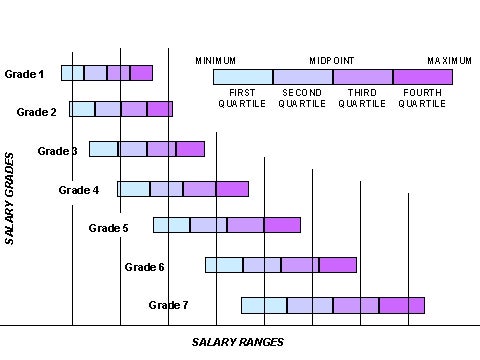At the conclusion of the job evaluation process, the compensable factors are evaluated and compared with similar positions across the university.
A salary range consists of a:
- minimum - the lowest wage paid to a new employee with limited or no experience in this specific position,
- midpoint - the "market" (or average) wage paid to one who is fully qualified and
- maximum - the highest wage paid for jobs in the salary grade.
Each salary range covers different jobs, e.g. Clerk and Grounds Worker, because they have the same relative value as determined by job evaluation.
Salary ranges intentionally overlap from one grade to another, as seen in the graph below. Fully qualified incumbents in a lower salary grade may be at the high end of their salary range, while the salary of a less experienced employee in a higher salary grade may be near the minimum of the range. It is possible that the salary of an experienced incumbent in a lower rated position will be the same as or more than the salary of an inexperienced incumbent in a higher rated position.
The graph below illustrates the overlap of salary ranges between salary grades.
Establishing Competitive Salaries
Salary surveys are conducted annually and analyzed to establish and maintain competitive pay levels with all the markets in which the university competes and recruits, as summarized in the following exhibit.
Exempt
Department Head and Above
- Market: National
- Salary Surveys: Customized surveys with data from selected private research universities
Below Department Head
- Market: Regional
- Salary Surveys: Customized surveys with data from selected private research universities
Entry Level
- Market: Regional
- Salary Surveys: Local surveys for service employees and salary data from the College Placement Association
Nonexempt
All Jobs
- Market: Local
- Salary Surveys: Local surveys of selected manufacturing and service employers (banks, insurance, health care, etc.), specialized surveys as needed for specific jobs, e.g. plumbers, radiation technicians, etc.
This market data is correlated with the job evaluation results and salary ranges are established. These ranges are then periodically reviewed and adjusted to reflect changes in the marketplace.
Determining Salaries
Starting salaries of new hires are normally placed within the first quartile of the salary range but occasionally may go up to the range midpoint to accommodate special recruiting needs. Salary progression in the range occurs over time, based on the salary budget and employee performance.
Subsequent to employment, salaries normally change as a result of a promotion, an annual merit increase or an adjustment to maintain equity.
Fair Labor Standards Acts (FLSA)
Federal Law: Rule 22121–22274 [04–9016] Enacted 1938, updated August 2004 and governs:
- Minimum Wage
- Overtime
- Record Keeping
- Child Labor Standards
Exemption Status is based on job status, job responsibilities and salary (not based on job titles). It is important to determine FLSA status for position during job evaluation process. In addition to job description, supervisor/department might be required to complete a FLSA questionnaire.
Employees are classified as exempt are exempt from the law if:
- employees are compensated with a set salary rather than hourly
- there is no requirement to pay overtime premiums
- employees are classified as executive, administrative, professional, outside sales or computer professionals
Examples of exempt duties and responsibilities:
- Hiring, firing, disciplining and evaluating employees
- Planning work
- Determining policies and procedures
- Authority to negotiate and sign contracts
Employees are classified as nonexempt are governed by the law if they:
- are compensated on an hourly basis
- must be paid time and a half (1.5) for hours in excess of 40 hours worked in a standard work week
Examples of nonexempt duties and responsibilities:
- Animal care
- Typing or word processing
- Preparing payroll
- Book keeping
- Answering phones


